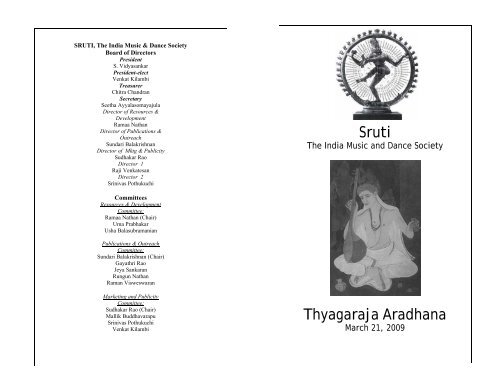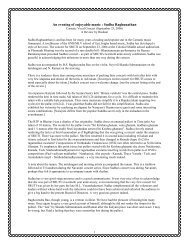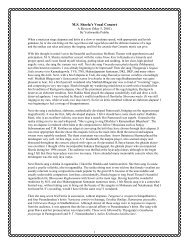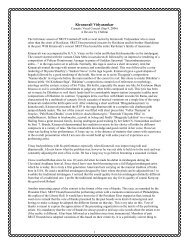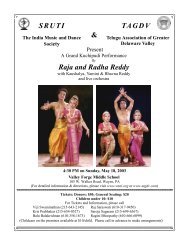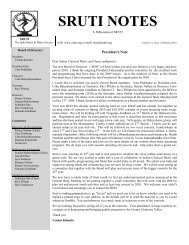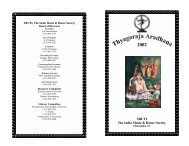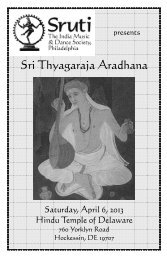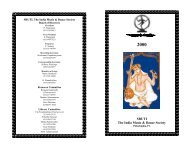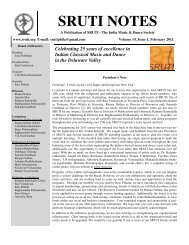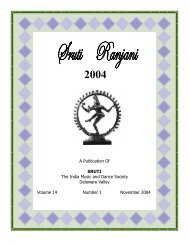PDF - Sruti Thyagaraja Aradhana
PDF - Sruti Thyagaraja Aradhana
PDF - Sruti Thyagaraja Aradhana
You also want an ePaper? Increase the reach of your titles
YUMPU automatically turns print PDFs into web optimized ePapers that Google loves.
——————————————————Table of Contents————————————————————-1. Note from the Publications Committee 12. Endaro Mahanubhavulu Andariki Vandanamulu 2P. Swaminathan3. <strong>Thyagaraja</strong>’s Quest for Supreme Wisdom 7Ch. Mallikarjuna Rao4. <strong>Thyagaraja</strong> Then and <strong>Thyagaraja</strong> Now 11Prabhakar Chitrapu5. Practicing for the <strong>Aradhana</strong> 17Madhav Nandan6. Quiz: Disciples of Tyagaraja (Sishya parampara) 18Veena Kanumalla7. In the News 198. Tyagaraja’s Kriti Sets 21Sriranjani Srinivasan————————————————————-The opinions expressed by the contributors of articles and reviews arepublished in a spirit of openness of communication and freedom of expression,but do not necessarily reflect the views of <strong>Sruti</strong>’s Board or its members.ram Brothers (F), Maha Vaidyanatha Iyer (G), Pallavi Seshayyar (H),Patnam Subramanya Aiyyar (I), Tillaisthanam Rama Iyengar (J), MysoreVasudevachar Tachur Singaracharlu Brothers (K), ManambuchavadiVenkatasubba Iyer (L).———-—————————————Tyagaraja’s Kriti SetsBy Sriranjani SrinivasanI S S U A E Y M Z I S I G Q S V O I X N Y F N B J A Y R H LP G Y J Y H W K A N N E N C H P I V A E P E S E R Z L Q M ED G A R A I N T X Y O G O B U Y T Z I Y Y K E D M A B O Z FN G W X D Q P H Q Q A G K B H P Q S X D K W M W R L B D E SW Z Z O A W S F X V A J I T A P U R I T U U Y S U P T H I DZ B T W R A O R B B A B I Z H M F I A Q F G Z D V J D C J HR X X A P R L B S S M S P V Q C A R K G I G L K O M B W E NK B H G M Y G O I P B D V M I J I A U D X H O A K B P D R GR E U H A U S A L G R H G W T T K N D T T U J L L C V E H UL M C J S V H D G L U B L F O M K G E H Z M O B N A W M P ZM C J Z A O R I G U G G V I I K N A Y N A S E O K G A O P CT I R U V O T T R I Y U R O C Z G M H R H G V M Y Z P R E HY Z L G A B Z T J U B Z Q F B G H F T B H N T F G Z U D S LT B O D S K B M W R X A C Y N F V I G A A P K H T H R T A ZK I E B T H L M D G C Y N Z T V R M N G M D G V T Z I F A WO F R K U B L F I M N X S D I A S A C B V R A A A D Q Z B IH K O U P E W K T A P J Q H H H R X F E E C P L I B U O O ED A E P V E A A P X Y F P C L A S X Y N O K L B H X N P H OC S T X V A M B U J R F A F G R I W P N V K E L M A K M S IJ M P C N M I G P I R K C A Y Q S H S P P W P J W G R Z S XJ E Z S I K E Y Q C W S U Q W F Y Q B R W B D G S Z G P N JA P R S T G D B Y O O L H Y F P K Y J E C Y O I P P E B V ZF O A R I Q K V N A M V J Q G F L C Z V G Y W H U U F P V SH F Y V Z J F H C P R R N V S W O C U K Z S K H Q M J U W LN K E R T E Q C J C B U Q P B C P P R U J I T B E Z N Y L PS P Z T G W Q V A V J F R X D V C B O C W E I Z A S E G Z UC B Z K P Y N R L P A T N N A T Z J H U O W L Q H X R I M VS C R A F Q C T E N K G T X K A E M J M F Q H P L C O H H IX J T S M N X T H V H I T W R Q U I D Z Q F I C O Y X L I FK D E P D P T V P D W U V Z V R I J K C Y F A V F N E N V QGHANA RAGAKOVURLALGUDINOWKA CHARITRAMPRAHLADA BHAKTI VIJAYAMSRIRANGAMTIRUPATITIRUVAIYYARUTIRUVOTTRIYURUTSAVA SAMPRADAYA(Sriranjani Srinivasan is a 6th Grader from Great Valley MiddleSchool and learns Carnatic music from Mrs. Kiranavali Vidyasankar.)———-—————————————21
mukhananda Sangeetha Sabha, was celebrated for four days from 27February to 2 March. Nadopasana Music Dais in Mumbai celebrated atwo day event Jan 31-Feb 1. On March 1 Sri Parthasarathy SwamiSabha organized a one-day event at Mylapore Fine Arts Club. <strong>Thyagaraja</strong><strong>Aradhana</strong> was even celebrated for the very first time in theremote area of Tezu Arunachal Pradesh on Jan 25.The following is a partial list of <strong>Aradhana</strong> celebrations in the U.S:At Siva Vishnu Temple of MD the <strong>Aradhana</strong> was held on January 17and 18.At Jacksonville, Florida the <strong>Aradhana</strong> was held on March 7 .The 17 th Annual Thygaraja <strong>Aradhana</strong> in Austin Texas was held onMarch 14.Cleveland <strong>Thyagaraja</strong> Festival commences on Thursday April 9 andends on Sunday April 19. Please visit www.aradhana.org for the completeschedule.At Sri Venkateswara Temple, Pittsburgh the <strong>Aradhana</strong> will be held onApril 25.The 33rd Chicago <strong>Thyagaraja</strong> Utsavam will be held during the 3-dayMemorial weekend, May 25– 27.NatyanjaliThe festival of Shivaratri is marked by a number of dance festivals inthe various temple towns of South India. In a way, these festivals arebringing back dance to where it once was prevalent. The practice wasrevived in a very small and symbolic manner at the famed NatarajaTemple in Chidambaram, a little over 25 years ago, the brainchild ofa few who were passionate about Indian music and dance. The trendinspired other significant dance festivals. Today, dance performancesare held in the temples at Thiruvarur and Thirunallar, Nagapattinamand Kumbakonam, Thanjavur and Pondicherry, besidesChidambaram. In addition, festivals are held in the temples of Chennai,like Sri Kapaleeswarar Temple, Mylapore.From the Publications Committee….The day long celebration of Saint <strong>Thyagaraja</strong>’s music by <strong>Sruti</strong> is oneof many in India and the diaspora which follows the <strong>Aradhana</strong> in Thiruvaiyaru.Every year <strong>Sruti</strong> publishes a booklet to mark the event. SriMallikarjuna Rao’s article “<strong>Thyagaraja</strong>’s quest for Supreme Wisdom”explores the Vedanta content in the compositions in the composer’spursuit of Moksha. P. Swaminathan was at the 162 nd <strong>Thyagaraja</strong><strong>Aradhana</strong> celebrations held on Bahula Panchami day on January 15 that Thiruvaiyaru and provides us with an eyewitness report. In the article“<strong>Thyagaraja</strong> Then and Now” Prabhakar Chitrapu continues thequest to understand the musical personality and human persona of thecomposer.The practice sessions for the group rendering of the Pancharatna Kritisand the Utsava Sampradaya Kritis encourages the coming togetherof the musical community. This period of preparation inculcates anenthusiasm and discipline in the participants. The day long celebrationprovides an opportunity to a large number of students of music to payhomage to the Saint/Composer. In addition <strong>Sruti</strong>’s <strong>Aradhana</strong> daymarks the beginning of the cultural season of the year. This year’sfeatured artist is the vocalist Nisha Rajagopal, accompanied by MysoreK. Srikanth on the violin and Trivandrum V. Balaji on the mridangam.Sincerely,Sundari Balakrishnan (balusundari@yahoo.com)Rungun Nathan (rungunnathan@yahoo.com)Gayathri Rao (gayathri.rao@comcast.net)Jeya Sankaran (sankaranj@aetna.com)Raman Visweswaran (ramanvv@hotmail.com)Book ReleaseIn 1999, ‘The Oxford Illustrated Companion to South Indian ClassicalMusic’ authored by Ludwig Pesch was published by Oxford UniversityPress. The second edition of ‘The Oxford Illustrated Companionto South Indian Classical Music’ by Ludwig Pesch is now out on thestands. This edition has received an excellent review in the “Hindu”———-—————————————Answers to Quiz: Umayalpuram (A), Tillaisthanam (B), Walajapet(C), Walajapet (D), Venkataramana Bhagavatar (E), Umayalpu-201
Endaro Mahanubhavulu Andariki Vandanamulu…By P. SwaminathanEndaro Mahanubhavulu AndarikiVandanamulu.. - There are manygreat men; salutations to all ofthem… so goes the final compositionof <strong>Thyagaraja</strong>’s pancharatnakrithi sung in a chorus by the assembledmusicians. The musicwas reverberating through the airinto Door Darshan for the benefitof people all over the world. It wasthe 162 nd aradhana celebration inhonor of Saint <strong>Thyagaraja</strong>. Theplace was Thiruvaiyaru, a smallvillage in the district of Thanjavurin south India, where saint <strong>Thyagaraja</strong>lived and attained Samadhi in19 th century. In this final pancharatna, <strong>Thyagaraja</strong> pays his obeisanceto the learned and virtuous souls at large. The song, noted for its richmixed diction of Telugu and Sanskrit, contains beautiful swaraksharaswhich are adorned by numerous chitta-swaras. Even though <strong>Thyagaraja</strong>had composed several pancharatnas, the “<strong>Thyagaraja</strong>Pancharatna” rendered in Thiruvaiyaru before <strong>Thyagaraja</strong>’s Samadhistands out the best. Its uniqueness lies in the structure of the krithis,swarakshars, chitta-swaras and the scope for chorus rendering etc.Brief history behind the aradhana celebration:*<strong>Thyagaraja</strong> aradhana has two aspects to its celebration viz. religiousactivities and the more popular and interesting musical rendering. Inthe beginning, there were no music concerts but only the pujas for<strong>Thyagaraja</strong>’s idol were performed by his grandson at the Samadhi.Upon his death, <strong>Thyagaraja</strong>’s disciple Thillaisthanam Rama Iyengartook the responsibility of celebrating the aradhana at SubbharamaBhagavathar’s residence. Rama Iyengar continued the daily pujas atthe Samadhi. Thanks to the Umayalpuram brothers (Sundara Bhagavatharand Krishna Bhagavathar) a granite structure was erected replacingthe old brick construction. Upon the demise of Rama Iyengarhis disciples Narasimha Bhagavathar and Panchu Bhagavathar continuedthe celebration. For the first time in 1908, Narasimha Bhagavatharheld a five-day aradhana celebration that included harikathaand music concerts. This celebration took place in Pachaiappa’s2val in Tyagaraja’s honor.I.___________________Which third-generation disciple of Tyagaraja’s was proficient in bothCarnatic and Hindustani music?J.___________________Which duo was known for their devoted knowledge of music theoryand history?K.___________________Which disciple of Tyagaraja was also his first cousin?L.___________________WORD BANKTillaisthanamTachurSingaracharluBrothersTillaisthanamRamaIyengarPallaviSeshayyar19WalajapetMysoreVasudevacharUmayalpuramVenkataramanaBhagavatarMahaVaidyanathaIyer(See page 20 for answers )(Veena Kanumalla is a 14 year old eighth grader at WissahickonMiddle School. She is learning vocal Carnatic music from KiranavaliVidyasankar. )———-—————————————IN THE NEWS….<strong>Thyagaraja</strong> <strong>Aradhana</strong> in India and the DiasporaThe <strong>Thyagaraja</strong> <strong>Aradhana</strong> is celebrated in India and elsewhere. Somelocations celebrate the <strong>Aradhana</strong> immediately after the BahulaPanchami day <strong>Aradhana</strong> in Thiruvaiyaru. Timing at other locationshave evolved- for example, the <strong>Aradhana</strong> in Clevelend commenceswith the music competition on Good Friday with the PancharatnaKriti rendering on the Saturday.This year the aradhana in Thiruvaiyaru was celebrated on January 15.New Delhi’s annual Tyagaraja Festival organized by the Sree Shan-ManambuchavadiVenkatasubba IyerUmayalpuramBrothersPatnamSubramanyaIyer
the way to bring out the bhava of the ragams. The practice sessionswere long and strenuous, but they were worth it because there werealways some sort of snacks to eat after! But along with the fun camesome very hard work. We had to stay committed, meaning that wehad to come to the practices regularly. The practices taught us to worktogether and helped us correct our mistakes. We had to make sure thatwe were all singing in sruti, because it was a really big group of people.I’m sure it was a big challenge for all of us. Some things I learnedduring the practices were: How to work as a team, how to manage mytime wisely, and practicing regularly.(Madhav Nandan is a 13 year old eighth grader at The WyndcroftSchool. He is learning vocal Carnatic music from Dr. Dinakar Subramanian.He also plays piano and tabla. )———-—————————————Quiz: Disciples of Tyagaraja (Sishya parampara)By Veena KanumallaWhat are the 3 branches of Tyagaraja’s disciples?A._____________ B._____________ C._____________Which renowned disciple of Tyagaraja documented many of hisguru’s kritis immediately after learning them?D._________________Which duo (also disciples of Tyagaraja) performed in a lecture-recitalformat?E._________________Which second-generation disciple of Tyagaraja’s earned the title“Maha” or great at the age of 12?F.__________________Which second-generation Tyagaraja’s follower earned the title“Pallavi” due to his ability to render complicated Pallavis?G.__________________Which second-generation disciple used the mudra “Venkatesa” or“Venkateswara”?H.__________________Pupils of this Tyagaraja follower originally organized the 5-day festi-choultry, 2 Thirumanjana veedhi. As is often the case in India, whenthe two brothers fell out, two factions were formed, known as Periyakatchi (supporters of Narasimha Bhagavathar) and Chinna katchi(supporters of Panchu Bhagavathar). Upon split with his brother,Narasimha Bhagavathar celebrated the aradhana in Kumbakonam butwhen he died Periya katchi too resumed the celebration in Thiruvaiyaru.Chinna katchi under the leadership of Panchu Bhagavatharformed “Thyagabrahma Vaibhava Prakasa Sabha” and elected PanditLakshmanachar as the president and Poochi Srinivasa Iyengar as thevice-president. With the formation of the sabha, many vidwans andvidwamsinis became its members with an annual fee of Rs10. Thecommittee members of this sabha assumed the responsibility of conductingthe aradhana between 1914 through 1940. With the demise ofLakshmanachar in 1919, Chinna katchi went through some roughtimes with infighting among the new leaders of the Sabha involvingMayavaram Vaidyanatha Bhagavathar, Thanjavur Govinda Bhagavathar,Sabesa Iyer and Soolamangalam Vaidyanatha Iyer etc. Howeverthe leaders managed to patch up their petty differences and theactivities of Chinna katchi continued as one group until 1925 whenBangalore Nagaratnamma appeared in the scene.In 1925, Nagaratnammaerected the current templefor Saint <strong>Thyagaraja</strong>around the Samadhi andperformed the kumbabhishekam.She handedover the keys to the templeto Ramudu Bhagavathar,great-grandson of <strong>Thyagaraja</strong>’sbrother. After gettinga court order from theThiruvaiyaru Sub-Magistrate executive committeeof Chinna katchi was able to perform the aradhana celebrationon the bahula-panchami day at the newly erected temple in 1925. Onthat day evening Palladam Sanjiva Rao gave the first concert for thearadhana. Starting in 1926, Chinna katchi’s rights to perform the aradhanaat the current venue were upheld by the court. In the same year,Ariyakudi Ramanuja Iyengar was elected president of Chinna katchi.When Nagaratnamma wanted to perform during the aradhana celebrationher request was turned down by both the factions, since duringthose days women were not allowed to perform during the aradhana.183
This heralded a new party, that of Nagaratnamma in the scene. Thusthere were three factions celebrating <strong>Thyagaraja</strong>’s celebration in paralleluntil 1940. Persuaded by common sense, the music lovers of thethree parties gave up their differences and united as one group tohonor Saint <strong>Thyagaraja</strong> in 1940. This was also the year when commonsense prevailed and women were allowed to perform during thearadhana and take part in the religious activities. In 1984, ChellamIyer (grandson of Gopalakrishna Iyer founder member of the firstThyagabrahma Mahotsava Sabha with Chinna katchi), S. Parthasarathyand few others of the Thillaisthanam tradition, formed a Trustcalled “Sadguru Thyagabrahma <strong>Aradhana</strong> Kainkarya Trust Madras”that even today continues the religious part of the aradhana celebration.The musical celebration is continued by the group formed in1940.<strong>Thyagaraja</strong> <strong>Aradhana</strong> 2009:THE 162 nd <strong>Aradhana</strong> celebration in honor of Saint <strong>Thyagaraja</strong> wasperformed at the Samadhi of the saint in Thiruvaiyaru, Thanjavur districton Jan 15, 2009 with the traditional rendering of the “pancharatnakrithis” by a group of musicians assembled under one roof. Even thecelestial angels greeted this occasion with a heavy down pour justduring the pancharatna krithi rendition. Earlier in the morning thetraditional “unchavrithi” was performed after special pujas to thesaint’s bronze idol in his ancestral home. The idol was carried in aprocession to the Samadhi led by the secretary A.K. Palanivel wherespecial abhishekam was performed simultaneously while the chorusrendering of the pancharatna krithis was being performed, followedby mangala aarthi.The chorus was rendered remarkably well by the assembled artistsand the audience was kept in rapt attention. Just to mention a fewprominent vocalists who participated in the chorus singing were T.V.Gopalakrishnan, Sudha Raghunathan, O.S. Arun, Neyveli Santhanagopalan,Anuradha Krishnamoorthy, Gayathri Girish and others.Prominent among the flautists were N. Ramani, Prapanjam SitharamaRao, Prapanjam Balachandran and others. Leading violinists wereV.V. Ravi, Neyveli Krishnan, Narmada and others. The singers wereaccompanied on the mridangam by Umayalpuram Sivaraman, SrimushnamRaja Rao and Thiruvarur Vaidyanathan. Earlier there wasnadaswaram recital by Thiruppamburam Brothers, Sheik Subhani andKhalish Beevi, Chinnamanur Kasim and others.This year’s celebration was inaugurated on January 11 by the violinmaestro Chandrasekaran by lighting the sacred lamp. Every day cele-4In Conclusion:Of course, one can go on asking many more curiosity questions. Howlong did he take to compose a kriti typically? Did he have intermediateversions that he improved upon? Were they documented?Indeed, we know that the famous kritis Jagadanandakaraka and EndaroMahanubhavulu both contain multiple mudra charanams. It isreasonable to think that <strong>Thyagaraja</strong> himself added these extra charanamsand made sure that there was no doubt in it, by adding hissignature again!How about the chronology of his compositions? Are the dates knownwhen he composed each kriti? Did not his students, who took suchpains to write down the lyrics and the music, write down a few numbersto capture the date?We know that the house in which <strong>Thyagaraja</strong> lived most of his lifeand produced for us the ocean of musical bliss has been around –alas, up until a year or so ago, when it was demolished for a modernmemorial to be built in its place! What a sad development for theadmirers of <strong>Thyagaraja</strong> and his history! Are any of his personal belongingspreserved? His Tambura? His Veena?This is the end of this article, but the beginning of a search for manyanswers. Over the years, I have tried to collect as much authentic informationas is available about <strong>Thyagaraja</strong>, and more recently, I havebegun to disseminate it via the website www.thyagaraja.org. I wouldbe grateful if you would look at it and join me in my search for moreanswers.(Prabhakar Chitrapu is a frequent contributor to <strong>Sruti</strong> publicationsand a past-President of <strong>Sruti</strong>. His interests include music, languageand philosophy. )———-—————————————Practicing for the <strong>Aradhana</strong>By Madhav NandanThe Pancharatna Kritis are five of Sri Tyagaraja’s finest compositions.They range from very upbeat natai to a relaxing varali. Thevarying ragams are natai, gowla, arabhi, varali, and sri. Our group ofstudents has had the privilege of learning these wonderful kritis fromKiranavali Akka. She showed us the proper way to sing the kritis and17
Thus, a careful comparison of various existent informations availableabout <strong>Thyagaraja</strong> is a good start to identify commonalities and contradictions.To this can be added findings of carefully conducted newresearch. But where is the source material for such research? To me,<strong>Thyagaraja</strong>'s own songs are a rich and possibly underutilized sourceof information. While the lyrics carry the music and tell about <strong>Thyagaraja</strong>'sdevotion, interestingly, one also comes across occasionalsparks of information about his way of life, personal habits, etc. Andclearly such information would be authentic, as it would really be anauto-biographical account, unaltered in time! I give below a wellknown song whose lyrics appear to give a glimpse of how <strong>Thyagaraja</strong>working style.Kaddanuvariki in Raga ThodiPallaviKaddanuvariki Kaddu Kaddani MoralaNiduPeddala Maatalu Nedabadda Mouno ?AnupallaviAddampu Chekkillache Muddugaaru Momu ChudaBudhi Galginatti Ma vadda Ravademi raCharanam:Niddura Niraakarinchi Mudduga Thamboora BhattiShuddha maina manasuche suswaramu thoPaddu Thappaka Bhajiyinchu Bhakta Paalanamu SeyuTaddayashalivi Nive Thyagaraaja Sannutha!Meaning:For those who say "there is", will the words of the elders who plead"yes, there is", "yes, there is", become false today?How is it that you do not come near us, who have an intention to seethe sweet face with mirror-smooth cheeks?Spurning sleep and lovingly holding the tambura,With a clean mind and with pure notes,Oh the One praised by <strong>Thyagaraja</strong>! You are the compassionate OneThat takes care of devotees, who worship you without breaking thevow!The kriti seems to suggest that <strong>Thyagaraja</strong> spent late hours in thenight, singing and perhaps composing new songs also. He would sitwith a clear mind and sing in clean notes to the strumming of hisTambura. Is that how he created the gems that we now enjoy againand again?bration started at8:00AM in themorning and concludedat midnight.The evening programsand primetimefeatures were telecastby AIR anddoor dharshan.Large number ofjunior artists andchildren learningmusic participated inthe program and paid their respect to Saint <strong>Thyagaraja</strong>. Everyday twoor three senior artists were featured during the primetime. Thoughthis year’s aradhana coincided with the Pongal holidays, people inlarge numbers attended the function from far off places including foreigncountries like US, England, Middle east, Australia, Sri Lanka etc.to pay homage to the saint and receive his grace. Saint <strong>Thyagaraja</strong>commands the respect due to an emperor of the musical empire eventhough he led the life of a mendicant in his life time. Approximately10000 people attended this year’s function according to the estimateprovided by the executive committee of the aradhana celebration.The house where the <strong>Thyagaraja</strong> lived in Thirumanjana veedhi is beingrenovated and will be ready for public view some time next year.The venue will be used as dhyana mandapam where the visitors canmeditate and experience the divine music of <strong>Thyagaraja</strong>. This projectis undertaken with support from all musicians as <strong>Thyagaraja</strong> hastouched or influenced each and every disciple of classical music.On a personal note:My journey to Thiruvaiyaru from Chennai was anything but fun. I hadbeen planning to attend this year’s celebration since October 2008. Inspite of my planning, the train reservation for me and my wife betweenChennai and Thanjavur were on waiting list and never got confirmedsince that night was the day before the great Pongal festival inTamil Nadu and all the trains were overbooked and sold out. Finallywe managed to get on to a bus on the afternoon of Jan 14 th andreached Thanjavur at 1:30AM on Jan 15 th . Checked into a dingy hoteland got two hours of sleep before we got up at 5:00AM to get readyfor the aradhana celebration. We reached the Samadhi at 7:00AMsince we did not want to miss the pancharatna krithi. From the time I165
entered the premises of the temple a surreal feeling came over me. Iwas excited to see so many musicians assembled under one roof topay homage to the greatest musical genius. I met quite a few of mymusician friends Kadri Gopalnath, Raja Rao, Sudha Raghunathan,Umayalpuram Sivaraman, N. Ramani, Neyveli Santhanagopalan justto name a few. Kadri Gopalnath and Raja Rao had kindly given us apass to sit alongside the musicians with a requirement that I had to bedressed up in veshti and a towel to cover the body (no shirt). I wasfortunate to get some time to converse with Umayalpuram Sivaramanwho briefly described the history behind the aradhana celebration.Later I got a chance to talk to A.K. Palanivel the secretary for thearadhana celebration. Palanivel is a recognized thavil vidwan. It wasremarkable to see free food served to all the attendees both in themorning as well as in the evening. I had good conversation with DeccanMurthy, the treasurer of the aradhana committee who is responsiblefor food arrangements. He mentioned that free food (all you caneat) was served two times a day during all the five days of celebration.The dining hall where the food was served can seat about 300 peopleat one time. On the average about 2000 people were served foodevery day.I also visited the great temple housing Lord Panchanadhiswara andGoddess Dharmasamvardhini. The temple is a spectacular buildingbut very poorly maintained as is often the case in India. It was heartrendingto see beautiful Thanjavur style paintings on the walls insidethe temple being painted over by artless crew showing marks of graffiti.The Thiruvaiyaru I had seen as a young boy with my father hasnot changed much. It has become more crowded with more buses andlot more dirt all over. It is very unfortunate that there are no hotels forthe visitors to stay during the aradhana celebration. In spite of all thisI would love to visit Thiruvaiyaru whenever I get a chance. If you askmy wife she may beg to differ with me.* The historical account presented here is based on the reports fromthe Hindu news paper, other local dailies and private conversationsthe author had during the visit. These are for informational purposeonly.(Dr. P Swaminathan is a former president of SRUTI; he has served inthe SRUTI committees in various capacities during the past 21 yearssince the foundation of SRUTI. He loves carnatic music and is a frequentcontributor to SRUTI publications. )———-—————————————happened the previous day and vented his anger thus: "You Imps! Toattend a marriage uninvited and without my permission is itself afault; to see there a dancing girl is an offense; to hear her sing a lasciviousJavali is a sin; but to make bold to repeat it inside my roofand to my hearing …. What shall I say?". Forthwith, the imps weredriven out and had to forgo their morning meal."I would suspect many modern biographies may choose to omit suchdetails!I wonder if there is word similar to hagiography to describe the idolizeddepictions of how saintly personalities looked. Take for example,the following two pictures.Contrasting Portraits of <strong>Thyagaraja</strong>The one on the left is taken from the early biography by MS RamaswamiAiyer, mentioned earlier. The picture is apparently in the JaganMohan Palace in Mysore. Notice how amazingly realistic the portraitis. One can clearly see the stern but calm look as well as details ofseveral physical features.The picture on the right hand side is one many people are probablyfamiliar with. It is due to S. Rajam and has become almost universallyused in our times. It is a beautiful picture, with ethereal and outof-this-worldtranscendence. However, it lacks realism and seems liketo simplified caricature of what one wants <strong>Thyagaraja</strong> to look like, asopposed what he really looked like. This is probably just one exampleof how society replaces truth with what it wants to see.615
formation from the Then to Now. As pointed by William Jackson inhis book "<strong>Thyagaraja</strong>: Life and Lyrics" (published by Oxford UniversityPress, Madras in 1991), biographies get replaced in time by‘hagiographies’ (i.e. biographies that idealize or idolize the person -especially a person who is a saint). The idea is that, while the originalbiographies are probably more descriptive of the real and human<strong>Thyagaraja</strong>, later works tend to dilute or delete some details and accentuateor exaggerate other aspects. These changes are typicallydriven by the changing view of the individual over time. The human<strong>Thyagaraja</strong> simplifies and evolves into a stereotypical vision of atypical bhaktha and saint. Let me illustrate this by quoting a ratheramusing paragraph from one of the early biographies, titled"Thiagaraja: A Great Musician Saint" by MS Ramaswami Aiyar andpublished by Asian Educational Services, New Delhi, originally in1927 and reprinted in 1986. It reads…."In appearance, <strong>Thyagaraja</strong> was a tall, lean man of brown complexion.His shoulders were broad,…face stern…jaws fleshy but a littlepointed at the chin…thulasimala around his neck; gopinama on hisforehead; his right hand, ornamented with a golden ring in the forefingerand a pavithra in the ring finger; the white silk-lined clothworn with careful folds between and the red silken turban with abroad unfurled tail flowing behind….Our musician inherited impetuosity and irritability of temper, somuch so, that, in spite of his being otherwise good, he was highlydisagreeable to his disciples and would at times treat them withharshness. For instance, a certain boy was, according to the customof the day, acting as a servant to Thiagaraja in return for the musiche learnt. The guru used to scold him downright for delay in the services,such as getting things ready for pooja, as well as, in repeatingthe songs taught and would even belabor him soundly. One day. Theboy faced the guru and said to him point blank: "For my dullness inlearning music, I may be cudgeled; but for your quickness in losingtemper, you certainly deserve thrashing"!Even his more important disciples, such as Umayalpuram Brothers,Manambuchavadi Venkatasubbaier, Walajapet Venkataramana Bhagavatharetc, had some experience of harsh treatment at the hands oftheir guru. One evening a few of them intruded upon a marriageparty in a village near Thiruvaiyar and eagerly listened to a dancinggirl's Javali, for which their guru had the greatest aversion. His pupilshowever liked it immensely and, on returning home, repeated itamong themselves. Next morning, Thiagaraja came to know what had14<strong>Thyagaraja</strong>’s Quest for Supreme WisdomBy Ch. Mallikarjuna RaoAananda and Vedanta VicharaAananda or happiness is two fold: vishayaananda - the relative andtemporary happiness that is based on baahya vishayas or externalobjects and the aathmananda or Purushaartha Moksha - the absoluteand permanent happiness that is based on aathma jnanam or selfknowledge.Vedasoffer these choices and also give the methodologiesto achieve them-Veda Poorva viz. samhitas and brahmanas forvishyaananda and Vedantha viz. Aaranyakaas and Upanishads forAathmaananda or Purushaartha Moksha. Samhitas and brahmanasprescribe Karma and Upaasana methods that lead to Purushaarthasviz. Dharma, Artha and Kaama. However, Karma phalam andUpaasana phalam have three defects- bandhakatvam or bondage,athipthikaratham or discontentment and duhkha mishritham or mixedwith pain – pain in acquiring the vishayas, more pain in their preservationand most pain in their loss sooner or later. It is Moksha that istotally free from these defects. However, there is no short cut to Mokshaother than Vedanta Vichara or engagement in Vedanta under acompetent and traditional guru. Indeed, Saint <strong>Thyagaraja</strong> proclaimsthis idea in his kriti “Guru leka yetuvanti guniki theliyagabodu”-without Guru-Sathguru (a traditional Guru who is established inBrahma Nishtta), it is not possible to know and abide in atma-jnanam.Vedanta in <strong>Thyagaraja</strong> KritisSaint Singer <strong>Thyagaraja</strong>, the soul of Indian culture and ParamaBhaagavathaagresara, followed the above method of Vedanta Vicharain his pursuit of Moksha. This great Singer-Poet, Maestro ofBhaava, Rasa and Thaala and Musical Composer nonpareil, gracedthe world during the period 1759 to 1847 A.D. He underwent rigorousVedic and Vedantic study under his father and mentor Sri KakarlaRaamabrahmam and also traditional Guru Swami Ramakrishnaananda.Later he was blessed by none other than Vara Naarada Guruswamiwith the unique gift of Svararnavam. Thus he had Shaastravichara under competent traditional Gurus- the basic requirement forMoksha saadhana.Saint <strong>Thyagaraja</strong> as a Jnana Nishttah is revealed to us in many of hiscompositions. But three among them presented for the present studyare outstanding in this context. Their deep understanding is invaluable7
in our own Vedanta Vichara and Moksha Sadhana.The first Kriti that is presented for discussion starts with the pallavi“Jnana mosaga raada-Garuda Gamana Vaada” in which <strong>Thyagaraja</strong>appeals “Oh Garuda Conveyed! Gift me the Supreme Wisdom. Isthere any (incompatible) controversy (that is a deterrent for the fulfillmentof my appeal)?” There are two aspects that are clear in this song.One, mere Vedantic Knowledge is of no avail. It needs to be convertedto the Supreme Wisdom. Next, divine grace is a MUST for thisWisdom. Saint <strong>Thyagaraja</strong> condenses the entire Vedantic thought intoa stunningly simple song.Saint <strong>Thyagaraja</strong> had the prerequisite knowledge of Vedas but appealsto Garuda Gamana for Jnanam, the Supreme Wisdom. Such aninvocation is perfectly justified. Indeed, Adi Shankara Bhagavatpaadain his Viveka Choodamani-verse 3 states:Durlabham thrayam yevaithath Dalvaanugraha hethukamManushyathvam Mumukshutham Mahaapurushssamshrayah“Self –Knowledge and Liberation cannot be obtained by mere meritoriousKarma and Upaasana. To be born as a human being, to haveutmost craving for liberation and to have a recourse in a competentand traditional guru- all these are the effects of Divine grace.raja (2nd Edition) by P. Sambamoorthy and published by The IndianMusic Publishing House in 1970). However, I could not find even thelyrics in any of the books I have had access to so far. There may bemore such known and yet unknown (to the general public) kritis of<strong>Thyagaraja</strong>. Of course, I do not have all the books on <strong>Thyagaraja</strong> kritis,especially those in languages other than Telugu and English, andit is quite possible some of my curiosities are put to rest there.Now let us consider the musical renderings of the songs, for whichthe lyrics are available. Are the recordings of all these songs publiclyavailable, for reference purposes at least? I have but 467 and I knowthat others have over 600 renderings. But are these renderings complete?It is well known that most musicians typically limit themselvesto rendering Pallavi, Anupallavi and usually the last or the mudracharanam. We also know that at least some songs have more than onecharanam. Are we missing something in omitting these additionalcharanams? If not, why would a great composer like <strong>Thyagaraja</strong> composethem in the first place? Out of curiosity, I tabulated the numberof charanams for all the 726 kritis and plotted them in a graphicalform, as shown below. It is interesting to observe that most kritishave either 1 or 3 charanams, whereas highest number of charanamsin 23! Many of the songs with a large number of charanams are usuallythe bhajana type of kirtanas, which are musically simpler.Again, in the kriti “Enduku Peddalavale”, Saint <strong>Thyagaraja</strong> imploringlyappeals to Lord Raama: “Why do you not gift me the wisdom ofthe great realized ones? Mere knowledge of Vedas, Sastras and Puraanas,Music, Drama, Rhetoric and Literature (Apara Vidya) Vedantaasand Thathvaarthas(Para Vidya) is of no avail without the ultimatewisdom by which the imperishable is attained (yaya thath Aksharamadhigamyathe)”.This refined intellect is termed “peddala valebuddhi” by <strong>Thyagaraja</strong>- the one that is called “agryaya, sookshmyayabuddhya” (sharp, subtle intellect) by Kathopanishad.Let us now examine how Saint <strong>Thyagaraja</strong> pursues his quest for theSupreme wisdom. This is clearly brought out in the next Krithi.Inthakanna Aanandamem Oh Raama! Raama! Santhajanulakellasammathiyai undugaaniAaduchu naadamuna paaduchu yedururaa veduchu manasuna koodiyunduta chaaluShree Hari keerthanache Dehaadi indriya sa moohamulu marachiThe 'Other' <strong>Thyagaraja</strong>It is fascinating now to turn towards the body of knowledge or lackthereof about the 'Other <strong>Thyagaraja</strong>'. In addition to recognizing variousholes in our knowledge of the personality and life of <strong>Thyagaraja</strong>,even what we know of it appears to have undergone interesting trans-813
In this essay, I shall attempt to make the point that even the Musical<strong>Thyagaraja</strong> is not completely known. As for the value of trying tounderstand the Other <strong>Thyagaraja</strong>, it is simply the curiosity of historyand science.The 'Musical <strong>Thyagaraja</strong>'I hope that I am wrong and that my knowledge is highly deficient,but I think that much remains to be known about our "Musical <strong>Thyagaraja</strong>".I shall try to justify my ignorance with some examples. Asimple one is the number of kritis that <strong>Thyagaraja</strong> wrote. We havecome across the number of 24,000 kritis, equal to the number of slokasin the Valmiki Ramayana. However, no book that I have comeacross or a web page that I saw has even 1,000 songs! What happenedto the rest? How could his faithful disciples not have cared to documentso many thousands? Or was that number only a hyperbole? Mypoint is that this is a simple and basic fact of the Musical <strong>Thyagaraja</strong>and we do not seem to have an accurate answer.Even among published works, there is not a complete agreement. Oneof the first books that I referred to was "The Spiritual Heritage of<strong>Thyagaraja</strong>", written by C. Ramanujachari & V Raghavan (publishedby Sri Ramakrishna Math, Madras in 1981). This book cataloged butonly 564 songs, with several well known songs missing, including thefamous Nata raga kriti Jagadanandakaraka. A more comprehensiveand almost monumental work is the "Compositions of <strong>Thyagaraja</strong>"written by TK Govinda Rao (published by Ganamandir Publications,India in 1995). This book contains an envious number, 688, of kritis,whereas a more recent book "The Complete Kritis of Sri <strong>Thyagaraja</strong>"by Maddali Venkata Subbayya (published by Icfai University Press in2006) contains 716 kritis. And then there is a recent recording byNedunuri Krishnamurthy of 8 <strong>Thyagaraja</strong> kritis, that were apparentlyhitherto unknown and were discovered from the Walajapet VenkataramanaBhagavathar manuscripts by two Professors from Hyderabadin 2005! After laborious comparison of all these works, the total isnow 726.But then there must be more. It is mentioned that <strong>Thyagaraja</strong> composedthis kriti "Svari Vedalina Parthasarathyni ganare" in RagaTodi, when he visited the famous Parthasarathy Temple in Madras("Sangita Jagadguru Sri <strong>Thyagaraja</strong> Kirtanalu", by Bhavaraju Narasimharao,T.S. Parthasarathy and published by Triveni Publishers,Machilipatnam in 1988, and also "Great Composers, Book II, Tyaga-sohamainade chaaluNee japamula vela Nee jagamulu Neevai Raajillunayya Thyagaraajanuthacharitha.In this Krithi, <strong>Thyagaraja</strong> asks “Is there Bliss(Supreme) that isgreater than (aparokshaanubhooti)? Oh RamaRaama (saguna EswaraRaama, the embodiment of Truth and all virtues)! Oh Raama(Nirguna Brahma Raama- the All-supporting Sath and the AllenliveningChith principle). It is this True Knowledge or Self-Knowledge in the form of Supreme Bliss that is known only to theenlightened vedantins (santhajanulu).Suffice it to understand this Self-Knowledge, the Aparoksha Jnanam,in unison with the subtle mind- intellect through the entreating touchof music and dance. Suffice it to understand this Soham-Knowledge(Self-Knowledge) available in sahaja samaadhi when sense organs ofperception and action dedicated to Hari Keerthana are withdrawnfrom the objective world. Suffice it to understand that in moments ofmeditation, the worlds of experience culminate in the brilliance ofJeevaathma Paramaathma Aikya Jnanam.Supreme wisdom and Uttama BhakthiBhagvan Ramana in his Upadesa Sara calls the Ultimate as UttamaBhakthi. He says “The actions done by the body and mind viz. pooja,japa and meditation are serially superior to each other. To chant orsing the glories of the Lord is good. Superior to that is loud japa. Superiorto that is soft japa. Superior to soft japa is japa done by themind. Mental japa is the subtlest and the best. Meditation withoutduality (SOHAM) is considered superior to contemplation with duality.By the strength of the soham thought, firm abidance in the existenceprinciple is gained which is free from thought modifications.This indeed is Supreme Devotion.”The term Japamulu applied by <strong>Thyagaraja</strong> includes the entire spectrumof physical, verbal and mental disciplines that are ingrained inall his activities. The “Sohamaina Aanandam” that is referred to in thekriti “Inthakanna Aanandamemi” is the very Sath-bhaava-susthih orUttama Bhakthi presented to us by Bhagvan Ramana in UpadesaSara.Lord Krishna equates Jnanee Bhaktha to Uthama Bhaktha in BhagavadGita Ch.7 verses 14 and 16.129
Chaturvidha bhajanthe maam JanaasukrithinorjunaArtho jijinaasu rarthaarthee Jnanee cha Bharatharshabha||Vudaaraassarva Yevaithe Jnaneethvaathmaiva mathamAasthithah ssahi yukthaathmaa maamevaa nuthamaam gathim||“Four kinds of virtuous men worship Me, Oh Arjuna, the distressed,the seeker of knowledge, the seeker of wealth and the wise. O bestamong the Bharathaas. Noble indeed are all these four. But the wiseone, I deem as My very Self. For, steadfast in mind, he is establishedin Me alone as the Supreme Goal”.Ecstasy of Self-KnowledgeLastly, I present to you another Krithi that reveals his ecstasy in Self-Knowledge.Entha Bhagyamu Ma Paala kalgithivi, Evvareedu mujjagamulothanakuChenthajeri sou janyudai baliki Chinta baaga thola ginchi brochitiviMunnu nee sarneepamuna velayu sath Munula nella naNimaadi leelalacheThinnagaanu paalanamu jesinattu Nannu gaachithivi <strong>Thyagaraja</strong>nutha“What a great fortune has come within our range of cognition! Whocan rival this (sath-chith-anaanda) in the three worlds of experience(waking, dreaming and deep sleep) of the Body-mind-intellect complex?Moving close with compassionate expressions and removing allsorrows thoroughly, you are the doubtless protection indeed!In the distant past, sages with siddhis such as anima or capacity forsookshma darshanam, who were close to you, were convincingly protectedby you. So also you have now protected and blessed me (withthe ekathvam of Chith roopa Athma and the Sath roopa Jagath whichis the very Ananda swaroopan of the Self)! Oh, <strong>Thyagaraja</strong> praised”.ConclusionIt is noteworthy Saint <strong>Thyagaraja</strong> refers to in his Krithis, Raama, interchangeablyin the context of Saguna Sakara Seetha- Raama andalso Nirguna Nirakara Atma-Raama. He is well aware of the scripturalmessage that Saguna Eswara Upasana (Dhyanam) is incompletewithout Nirguna Brahma Upasana (Nidhidhyasanam); and Nirguna10Brahma Nidhidhyasanam is impossible without Saguna Eswara Dhyanam.<strong>Thyagaraja</strong>’s Raama signifies both and he revels in the abidancein either as per his musical mood, although he is a Jeevan mukthawith the cognitive conviction of “Soham” and “Thathavam Asi”declared in our scriptural mahavakyas. All glory to Saint <strong>Thyagaraja</strong>.All glory to Raama the Jagadanandakaraka – The One RealitySatchit Anandaswaroopa whose proof is the very creation itself withits multiplicity of namas and roopas.(Mallikarjuna Rao is a retired marketing executive living in Chennai.He was a disciple of the late Sri R.K.Venkatarama Sastri in classicalCarnatic music and a disciple of H.H Swami ParamarthanandaSaraswathi, Chennai in Vedanta. The article was provided by the author’sniece, Dr. Gayathri Rao.)———-—————————————<strong>Thyagaraja</strong> Then & <strong>Thyagaraja</strong> NowBy Prabhakar ChitrapuThe Then was not so long ago. It was 1847, just over 150 years, when<strong>Thyagaraja</strong> was still a live person, in flesh and blood, with all his humancharacteristics and scholarship. No more and no less.Since then, however, <strong>Thyagaraja</strong> has grown both more and less. Hegrew more in fame and less in detail. His music propagated and flourished,bringing joy to multitudes and livelihood to musicians and othersin related professions. The details blurred and <strong>Thyagaraja</strong> as aman and the totality of his works became hazy and sometimes a matterof myth.It does not have to be so. We know of many men and women thatlived centuries before, whose lives and work details are still preservedwith great care and pride. As examples come to mind such names asMozart, Beethoven, Franklin, Lincoln etc, whose lives are so welldocumented. Unfortunately of the pride of our music, <strong>Thyagaraja</strong>, weknow comparatively little.One may say, however, that <strong>Thyagaraja</strong> is mainly known for his music.That makes for the most important person - the "Musical <strong>Thyagaraja</strong>".Thanks to his devoted students and their lineages of subsequentmusicians, this <strong>Thyagaraja</strong> is well preserved. The rest is - the "Other<strong>Thyagaraja</strong>". Is it so important if this <strong>Thyagaraja</strong> is only vaguelyknown? Is not such knowledge strictly secondary?11


